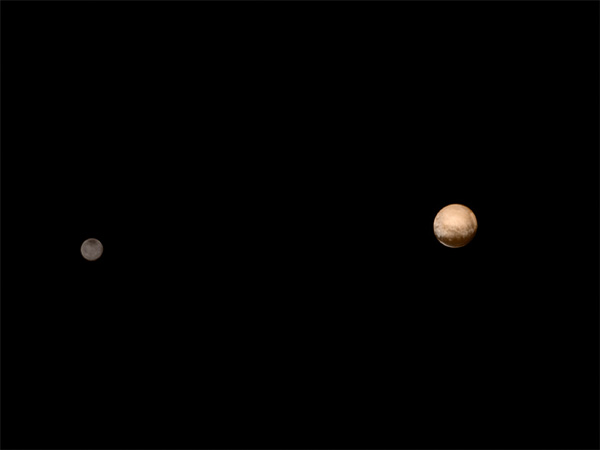Pluto shows first sign of geology to approaching New Horizons
Updated: 2015-07-11 16:22
(Xinhua)
|
|||||||||||
LOS ANGELES - As the latest image from the New Horizons spacecraft appeared on Friday, scientists are just starting to see Pluto' s geology.
|
 |
|
Pluto (R) and its moon Charon are pictured from about 6 million kilometers in this July 8, 2015 NASA handout photo from the New Horizons Long Range Reconnaissance Imager (LORRI). [Photo/Agencies] |
Mission scientists received the the newest black and white image in the morning on Friday from Long Range Reconnaissance Imager (LORRI) aboard New Horizons. At this range, Pluto is beginning to reveal the first signs of discrete geologic features, NASA said in a statement.
From the latest portrait, which was taken on Thursday from 5.4 million kilometers away, with a resolution of 27 kilometers per pixel, scientists are able to identify distant surface formations, including a polygonal complex band of terrain stretching east-northeast across the planet, approximately 1,000 miles long, and an immense dark band near the south pole that's now being called the "whale".
"We're close enough now that we're just starting to see Pluto's geology," said New Horizons program scientist Curt Niebur, "It's a unique transition region with a lot of dynamic processes interacting, which makes it of particular scientific interest."
There will no doubt be many similar moments to come. New images and data are being gathered each day as New Horizons speeds closer to a flyby of Pluto next week, following a journey of 3 billion miles.
Pluto's closest approach is scheduled for next Tuesday, when New Horizons will pass within 10,000 km of the dwarf planet's surface, travelling at a speed of 43,000 km per hour.
After a voyage of nine years, New Horizons is almost 4.8 billion km away, where radio signals, even traveling at light speed, need 4.5 hours to reach Earth. Round trip communication between the spacecraft and its operators requires about nine hours.
The piano-sized probe will perform the first close range study of the distant, icy world and its five attendant moons before continuing its journey deeper into the Kuiper Belt to examine one or two of the ancient, icy small worlds in that vast region, which is at least 1.6 billion km beyond Pluto.
Today's Top News
SCO summit opens in Russia's Ufa
Want to divorce? It's a long line in Guangdong
Panda lease system to be reformed
SCO can play major role in Silk Road, Xi says
Official denial raises doubts over '40-year-old meat' story
BRICS 'disappointed' by US failure to ratify IMF reform
BRICS summit condemns WWII 'misrepresentation'
Stocks surge as government moves to save market
Hot Topics
Lunar probe , China growth forecasts, Emission rules get tougher, China seen through 'colored lens', International board,
Editor's Picks

|

|

|

|

|

|






